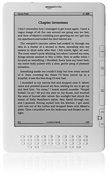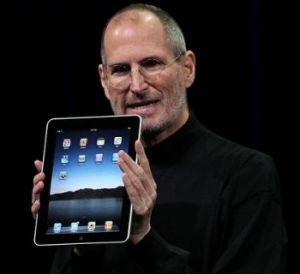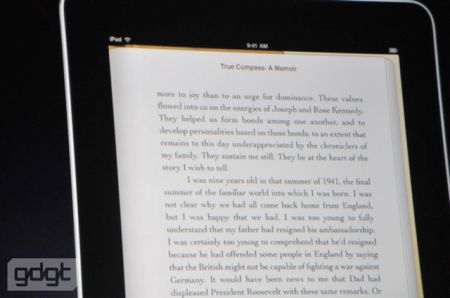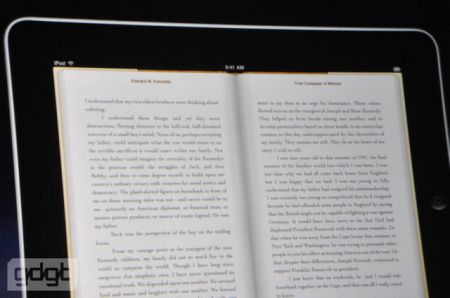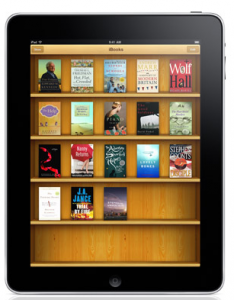 Yesterday morning, I headed to the Palo Alto Apple Store, spent an hour waiting in line, then finally gained entrance to the store. And who entered alongside me? Steve Jobs! An auspicious beginning. I left with a 32 gig iPad, took it home, and started playing particularly with the eBook reader. Here are my very early impressions:
Yesterday morning, I headed to the Palo Alto Apple Store, spent an hour waiting in line, then finally gained entrance to the store. And who entered alongside me? Steve Jobs! An auspicious beginning. I left with a 32 gig iPad, took it home, and started playing particularly with the eBook reader. Here are my very early impressions:
15 months ago, I bought a Kindle and returned it. I just couldn’t read with it at night (a non-starter for me), and figured that Apple would eventually get it right. Well, they largely have. The iPad initially feels a little heavy. But, it’s actually no heavier than your average hardback book. Plus it’s fairly easy to hold. Score one for the iPad.
Then, when you fire up the eBook reader, you instantly like what you see. The fonts are crisp, and the images are in color, which means that you can read children’s books, comics and other graphic intensive texts. Plus, you can change the size and kind of the font. You can adjust the brightness of the screen. And, in some cases, you can even alter the background color of the screen. (Most of this you can’t do with the Kindle.) All of this contributes to a reader-friendly screen that’s easy on the eyes. And, yes, I can read with this device at night. (Readers make other good observations in the comments below.)
How about buying books for the iPad? Well, it’s pretty easy. Both Apple and Amazon sell books for the device, with prices generally ranging between $9.99 and $12.99. Rather notably, they also offer access to a sizable collection of free books in the public domain. (You can get more freebies here, too.) Overall, Amazon has a much larger inventory, and their books tend to be cheaper. But otherwise these are pretty similar services. And, because Apple now has a far superior device, you have to wonder whether this is the beginning of a big shift in the book market. In five years, Amazon might not be quite the behemoth it is today — something that’s probably letting Steve Jobs sleep easier than Jeff Bezos at night.
A final point worth mentioning here: Neither company will let you have true ownership over the books you buy. Both vendors lock down their books, dictate the operating environments in which you can read them, and control the user interfaces that shape the reading experience. (PC World has more on that here.) You don’t have much ultimate control over the underlying file. So the upshot is that you had better like the iPad (or Kindle) reading experience before deciding to amass a large and costly library.
Now for a few random observations:
1) The video generally looks great (unless, of course, it’s produced in Flash). I was really impressed with the quality of YouTube videos, and Netflix movies (free app here) stream over the iPad rather brilliantly.
2) On the downside, I found typing on the iPad to be rather difficult — even more so than typing on an iPhone. The device is large enough that it’s hard to stretch your fingers to reach various keys. Maybe I will get a hang of it. But, for now, it’s unwieldy.
3) The New York Times and Wall Street Journal have developed new apps for the iPad, and they deliver a pleasant reading experience, to be sure. But I don’t see this suddenly making consumers any more (or less) willing to pay. The concept of the iPad saving the newspaper industry seems fairly overplayed, I’m sorry to say.
4) Is this a must-have device? Or just nice-to-have? Right now, I’m inclined toward the latter (and so is Slate). Aside from the eBook reader, your home computer or smart phone can accomplish most of what the iPad can. However, the iPad will rapidly differentiate itself. It will become a nice low-cost, portable computer — one that lets you store data in the cloud, and provides access to a large volume of cheap or free software (at least more than your average consumer normally gets). Give it a year. Wait for the flood of apps to come. Wait for innovative software developers to extract the potential of this machine, and wait for Apple to make the iPad lighter, cheaper, and even faster. Right now, it’s not a game changer. But it will be down the line.
Are you a new iPad owner? Have any thoughts in general? Or particularly about the eBook reader? Add them to the comments below, or send them our way. We look forward to hearing what you have to say …
